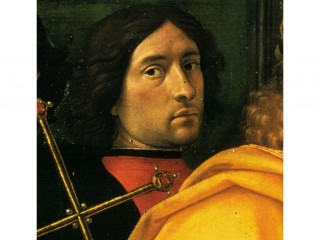
Domenico Ghirlandaio biography
Date of birth : -
Date of death : 1494-01-11
Birthplace : Florence, Italy
Nationality : Italian
Category : Famous Figures
Last modified : 2011-03-07
Credited as : Fresco painter, church of S. Maria Novella Florence, the Adoration of the Magi (1488)
The Italian artist Domenico Ghirlandaio was the leading fresco painter in Florence in the late 15th century.
Domenico Ghirlandaio, born in Florence, was the son of the goldsmith Tommaso Bigordi. According to Giorgio Vasari, Tommaso was called Ghirlandaio (the garland maker) because he made metal garlands. Vasari also declared that Domenico studied painting with Alessio Baldovinetti. Twice married, Ghirlandaio had nine children, one of whom, Ridolfo (1483-1561), was also a painter. Ghirlandaio died of the plague in Florence on Jan. 11, 1494.
Ghirlandaio painted sweeping, well-filled but uncrowded compositions and easy portrait likenesses. He was interested in classical antiquity and aware of contemporary Flemish painting. He supervised a large shop of assistants, chief among whom were his brothers Davide and Benedetto and his brother-in-law, Bastiano Mainardi. The chief problem in Ghirlandaio scholarship is the sorting out of his work from that of his various associates.
A recently uncovered fresco, the Madonna of Mercy and the Lamentation over Christ, in the Church of Ognissanti, Florence, is among Ghirlandaio's earliest (ca. 1475) extant works. The fresco, painted for the Vespucci family, displays Ghirlandaio's characteristic skill at portraiture and includes a portrait of Amerigo Vespucci.
In the frescoes (ca. 1475) in the Chapel of S. Fina in the Collegiata, San Gimignano, Ghirlandaio blended painted with real architecture to create open designs filled with portraits of the local citizens. One scene, the Funeral of St. Fina, includes a cityscape depicting the towers of San Gimignano.
In the Last Supper (1480) in the Church of Ognissanti refectory Ghirlandaio painted an extra bay into the scene, which appears to continue the real architecture of the refectory into the fresco. This device is remarkably effective, though it somewhat detracts from the story. The iconography is traditional, with Judas seated opposite Christ, but Ghirlandaio seems to anticipate Leonardo da Vinci in his arrangement of the disciples into groups of twos and threes.
Ghirlandaio's fresco, the Calling of Peter and Andrew, in the Sistine Chapel (1481-1482), Rome, is especially successful in its sense of openness and is one of the clearest and most easily read in the chapel. Characteristically, the "calling" is witnessed by crowds of onlookers and contains numerous contemporary portraits.
The Sassetti Chapel frescoes (1486) in Sta Trinita, Florence, are among Ghirlandaio's best work. The episodes, of the life of St. Francis, are embellished by contemporary Florentine settings and personalities. In the lunette scene depicting Francis receiving the rules of the order, the setting is the Piazza della Signoria with a view of the Loggia dei Lanzi. Among those witnessing the event are Lorenzo the Magnificent, Francesco Sassetti (the donor), and the writer Angelo Poliziano. The scene showing Francis resuscitating a child is set in the Piazza Sta Trinita with views of the bridge and Church of Sta Trinita.
The most extensive fresco cycle Ghirlandaio executed, in the choir of the church of S. Maria Novella, Florence, was commissioned on Sept. 1, 1485, by Giovanni Tornabuoni. The artist promised to complete the project by May 1490. The frescoes tell the stories of St. John the Baptist and the Virgin Mary in 14 separate scenes arranged in four registers along the sidewalls of the choir. The style makes it clear that much of the actual painting was done by assistants. Recently restored, the frescoes are exceptionally effective decoration.
Ghirlandaio did a number of panel paintings. He preferred working in tempera, although he undoubtedly was familiar with the oil technique. In the Adoration of the Shepherds (1485) the swarthy peasant types seem to derive from Hugo van der Goes's Portinari Altarpiece. One of Ghirlandaio's most appealing panels is the Adoration of the Magi (1488). As in most of his work, the colors tend to be rather harsh and contrasty; nonetheless, the scene has a quiet piety and charm. It includes a particularly fine landscape viewed through the posts of the shed behind the Virgin and Child. Two portraits, Francesco Sassetti and His Son and the Grandfather with His Grandson, are noteworthy for their restrained gentleness. Ghirlandaio's last panel, the Visitation (1491), is rather simple in design and seems to anticipate the balanced compositions of the High Renaissance.
















